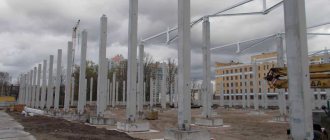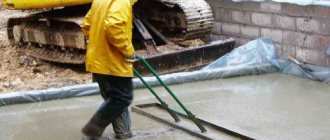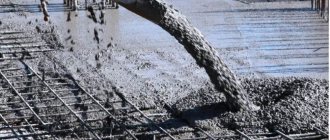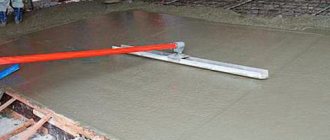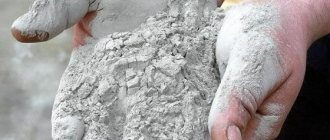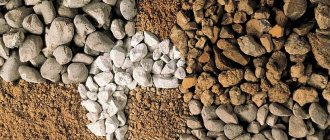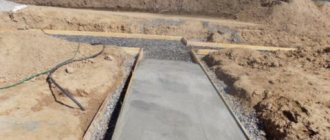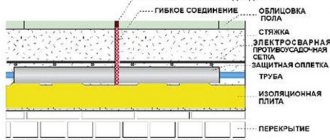Concrete is a unique material. It is used not only in construction for the construction of buildings, from the strongest foundation to the complete construction of walls and roofs. You can also make piece items from it, such as paving slabs, balusters, vases and even countertops for the kitchen or living room. Modern methods of concrete preparation and processing make it possible to elevate this material almost on par with natural materials such as granite or marble. Although it is not as aesthetically pleasing as the latter, it is certainly known what it is made of, and there is no obligatory background radiation that natural stones often have. If you decide to abandon purchased concrete, then you should figure out how to make concrete with your own hands of the required quality, which will solve the problem at hand and will have sufficient strength and durability.
Although the process of preparing concrete is quite simple, it is necessary to take into account a number of features and points that will determine its quality and suitability. Depending on the purpose for which it is prepared, both the recipe and the method of its use change. So, first of all, let’s define what concrete is and what main characteristics it has.
In general, the composition of concrete is a mixture of cement mortar and filler. So the main ingredients are:
- Cement;
- Sand;
- Filler (gravel, slag, crushed stone, pebbles, etc.).
In addition, modern technologies involve the use of special additives - plasticizers. Their role is to give concrete some unique properties.
The main characteristic of concrete is its compressive strength. We will not go into detail about how concrete was assessed for strength at different times, and will focus on the modern, universally used system. The strength of concrete is expressed in mega pascals (MPa), which determine the pressure that a certain class of concrete can withstand. Based on strength, concrete is divided into grades. In the CIS countries, according to GOST, classes are designated as B7.5 - B80. The difference depends on the type of cement used (M300-M600), sand and fraction, as well as the type of crushed stone. The number in the class name indicates the pressure in MPa that concrete can withstand in 95% of cases.
The simplest version of concrete is a simple mixture of cement mortar and coarse sand. This type of concrete is mainly used as a base for foundations. Preparation can be done directly at the bottom of the formwork under the foundation. In this case, very little water is added so that the mixture acquires the density of wet soil. There is no need to talk about strength in this case, but such concrete is excellent as protection for the main foundation from subsidence and excessive moisture.
More durable concrete involves the use of a variety of crushed stone as a filler with a fraction from 2-3 mm to 30-35 mm. The quality of concrete directly depends on the purity and composition of all its components. So before you figure out the proportions and preparation methods to make a concrete solution correctly, it’s worth considering each component separately.
Requirements for concrete components
Cement
Cement is the main and only ingredient of concrete that binds all components together. Portland cement is the most suitable for preparing concrete. It is distinguished by an increased and prevailing content of calcium silicates (up to 78-80%), which ensures improved adhesion and bonding of materials. However, depending on the task at hand, other types of cement are also used.
The most suitable grade of cement for private construction is 500. You can also use standard M400, but this will affect the durability of the same foundation.
In addition to good adhesion, Portland cement is better suited for working at low temperatures. Even so, you cannot work with concrete at temperatures below 16 degrees. If there is a good reason to use concrete at lower temperatures, then special additives and plasticizers will be required, but more on that later. For work in hot weather, Portland slag cement is better suited.
In the domestic marking of cement, in addition to the designation of its declared strength in the same MPa, which is marked as a brand, there is also the designation “D”, after which a number is placed indicating the amount of foreign impurities in the cement. Actually, for the preparation of high-quality concrete, cement M500-D0 or M500-D20 is suitable, that is, with impurities from 0 to 20%.
The cement must be dry and free-flowing. Under no circumstances should you purchase damp or lumpy cement, and you should also not save too much and buy unlabeled, stale or discounted cement. After all, concrete will be used to construct important elements of the house, so your well-being and safety depend on it. In unsuitable conditions, cement can very quickly absorb moisture from the air and lose a significant part of its qualities.
It is better to purchase the required amount of cement a maximum of 2 weeks before direct use or a few days in advance. Check the presence of markings and the integrity of the packaging.
Sand
Regardless of the aggregate used, crushed stone or gravel, sand will also be required. Only in some cases do they do without it, when it is possible to compact and select large aggregate so that the gaps between all components are minimal.
Sand suitable for preparing concrete should have a fraction of 1.5 to 5 mm, best when it has a uniform size with a variation of no more than 1-2 mm. The sand should not contain foreign impurities. All kinds of plant debris, construction debris and any inclusions that may disintegrate or rot over time will adversely affect the strength of concrete. To be on the safe side, if the sand is not completely clean, it is better to pass it through a sieve with fairly small cells. Actually, the same applies to crushed stone.
River sand is best suited; although it is more expensive than gully sand, it has a suitable grain size and does not contain silt inclusions or clay. Unlike cement mortars, which are used for the construction of brickwork or plastering, in which the presence of clay can only help, because it will be easier to level it, it is not permissible in concrete. It is important to ensure maximum adhesion of the cement mortar with large aggregates, which determine the overall strength of concrete. So it is better not to use sand with loam or grains less than 1 mm at all for preparing concrete, because it is very difficult to get rid of them. To do this, they use the procedure of washing and settling the sand, which, even in industrial conditions, is not always profitable or easy.
Alternatively, for areas near which there are stone quarries, artificial heavy sand can be used. It is obtained as a result of crushing rocks and is characterized by greater mass and density. If it is washed properly and separated by particle size, it will be even slightly better than river sand. It is only important to take into account when preparing and when using that the concrete will turn out to be much heavier; this is important if it is used in the construction of screeds over interfloor ceilings. A significant obstacle to the use of heavy artificial sand may be the possible increased background radiation, which depends on that of the parent rock.
Aggregate. Crushed stone, gravel
The main strength of concrete comes from filling it with gravel or crushed stone. Sea or river pebbles are in no way suitable, because their surface is polished with water and does not provide proper adhesion to the solution. The best material is obtained from crushed rock.
It is important to take into account the characteristics of the breed that was used. Expanded clay or other similar materials are also often used, which are quite strong, but at the same time light. Below we will consider the principle by which you can select the appropriate material for preparing concrete, which will provide the necessary strength and reliability for specific situations. The size of gravel or crushed stone can vary from 8 to 35 mm; larger pieces are used mostly in production, and even then rarely. As with sand, it is desirable that the aggregate contains as little dust or clay inclusions on its surface as possible. The debris must be picked out before the gravel goes into the solution. The higher the roughness on the particle faces, the better. Reliable grip depends on this.
To prepare concrete yourself, it is better to choose either an aggregate, which itself has particles of several sizes, or mix coarse gravel with medium gravel. In the absence of professional equipment for compacting concrete, this will ensure a tighter fit of the aggregate particles to each other and will prevent the formation of large voids. Otherwise, the latter will be filled with mortar, and this will affect both the strength of the concrete and the consumption of the mortar itself.
For storage, it is better to store both sand and crushed stone or gravel in bulk near the place of use. In order to prevent contamination of materials and moisture from the soil, it is better to place the embankments on a spread tarpaulin or an area with a solid base. In the simplest case, when materials are poured directly onto the soil, the lowest layer that is in contact with it should not be used.
Water
The moment of choosing water is very important. There is, of course, no question of using any special water. However, it must be clean and free of alkaline or acidic foreign matter. You cannot use river or, especially, lake water, which contains more than enough inclusions. It is best to follow a simple rule: water that is suitable for drinking is also suitable for making strong and good concrete at home. Only by following this rule can you expect that the concrete will be durable and last a long time without any damage or destruction.
Supplements
- Lime. Some craftsmen add a little slaked lime to the concrete composition, this increases the workability of the solution. This somewhat facilitates the process of leveling the surface of the concrete screed or cast section of the porch or outlet. And yet, in addition to this, lime can interfere with the normal bond between cement and aggregate, which will affect the strength. The choice of whether to resort to using lime or not remains with the master, when he knows exactly what is best at the moment. There is no need to extinguish lime yourself for a long time now. Instead, ready-made slaked lime is used, which is sold in construction stores and is called fluff.
- Plasticizers. To give the concrete solution greater fluidity or reverse viscosity, various plasticizers are used, which change the properties of the solution in a given direction. The use of plasticizers can increase or decrease the amount of water required to prepare the solution. For work such as pouring a foundation, plasticizers may not be used, but they can play an important role if the reinforcement is quite dense or the foundation has a complex shape. At the same time, more fluid concrete will fill all voids and branches faster and more reliably, which will speed up the process and improve the result.
Plasticizers for concrete
- Auxiliary components. In addition to the above, special additives can be used to impart more advanced properties to concrete. Thus, additives can be used to ensure that concrete sets and hardens at low temperatures or in the presence of large amounts of moisture. Appropriate additives are used for various purposes. It is important to decide whether to use them and select the necessary additive at a hardware store. Carefully study the instructions for use and properties of the additive. If the conditions in which concrete will be used have limiting parameters in terms of temperature or humidity, then additives and plasticizers will be indispensable.
- Reinforcing substances. In addition to concrete aggregate, specific additives are often used for additional reinforcement. So, when using concrete, a special polypropylene or polyvinyl chloride fiber is used to make a fairly thin screed. It itself is soft and not particularly strong, but it will help avoid situations where concrete cracks at the points of convergence of floor slabs or in the case of an unstable base when forming the main floor on top of soils.
Concrete components
Let's see what is included in concrete and how it affects its characteristics. There are four required components, plus various additives:
Cement
Cement is the “glue” that holds the other components together tightly. It is its brand and quantity in the mixture that determines the brand of finished concrete. (Of course, with the correct proportions and if you follow the installation technology.) It gives the solution plasticity, and then reacts with water, and thanks to this, the semi-liquid mixture gradually hardens into stone.
Mainly, Portland cement grades M400 and M500 are used. M800 produces super-strong cements; they are used only in specific industries, for enormous loads. These mixtures themselves contain various additives.
Aggregate
If cement gives the solution plasticity and elasticity, then fillers, like reinforcement, are responsible for hardness, impact resistance, and wear resistance. There are small and large aggregates.
The fine aggregate is sand. A dry mixture of cement and sand is called sand concrete or CPS (cement-sand mixture). By diluting it with water, masonry, plaster and floor screed mortars are obtained. But concrete also requires a large aggregate - crushed stone.
Coarse aggregate gives concrete the necessary strength. It does not gain strength over time, like cement, and therefore you need to buy it 2-3 grades higher. So, for concrete M300 it is worth taking crushed granite stone. There is no point in using granite to prepare grades smaller than M250; ordinary crushed gravel will do.
Crushed stone differs not only in origin, but also in fraction (grain size in mm):
- small (up to 20);
- medium (20-40);
- large (from 40)
The largest crushed stone is not always the best. After all, homogeneity and density are important for concrete, otherwise there can be no talk of any strength. And a large fraction is difficult to compact, especially if there is reinforcement. Concrete with such crushed stone tolerates bending loads worse. In addition, it has more pores, which means it allows water to pass through.
The aggregate itself may also be porous. If granite screenings and gravel are placed in heavy concrete, then expanded clay, dolomite crushed stone, and slag pumice are used in light concrete. For warmth and light weight of the structure, this is what you need.
Fine crushed stone increases the density, mobility, and frost resistance of the mixture. But it also has disadvantages - concrete shrinks more with it.
In concrete mortar for densely reinforced structures, it is better to put crushed stone of a finer fraction and add more cement.
Concrete with fine crushed stone is also suitable for making paving slabs, columns, and thick floor screeds (from 40 mm). It is good for thin, narrow and tall structures, and products with complex shapes.
How to make washed concrete with your own hands
Anything large, especially where the main load comes from top to bottom, is made with large crushed stone. These are foundations, floor slabs, massive road surfaces. It is usually better to use several fractions and sand evenly. As a result, smaller particles will fill the voids between larger ones, and together they form a monolith.
Supplements
There are many concrete additives currently sold. This:
- plasticizers, which further increase the mobility of the mixture;
- antifreeze and hydrophobic additives;
- hardening accelerators and retarders.
In dacha and garage conditions, you can not buy expensive compounds, but use folk remedies for not very important structures (blind areas, paths). For example:
- dishwashing detergent solution - as a plasticizer;
- PVA glue - for strength;
- silicate glue - for waterproofing;
- ordinary salt - to lower the freezing point of water in the solution;
The main thing is not to get too carried away; none of these components should account for more than 5% of the volume of the entire mixture. Some of the strength will still be lost, but if there is a reserve, then why not. Some kind of savings.
Selection of ratios of materials for preparing concrete
Different purposes require different concrete compositions. So, to form a foundation for a house, you need strong concrete with the inclusion of large crushed stone with elements ranging in size from 20 to 35 mm, and the amount of mortar is sufficient to fix the aggregate. In this case, the solution must be fluid, because it is necessary to firmly compact the concrete and remove all air bubbles from it. However, before pouring the main part of the concrete, you should equip the substrate. For this purpose, the easiest to prepare and less durable concrete, B7.5, is used, which in addition to cement mortar may contain only coarse sand. Moreover, for this purpose the concrete solution is not made liquid, but more similar in consistency to wet soil.
To construct foundations, you will need an average size fraction of filler and still a liquid solution. This will ensure ease of distribution of the solution over the surface in a fairly thin layer. Also, the fine and medium fraction of the aggregate is indispensable when forming elements such as balusters, decorative elements or garden utensils and fills, small elements such as a porch or steps.
The composition of concrete in terms of ingredients and their ratio must be carried out in accordance with GOST 7473-94 and SNiP 5.01.23-83. This takes into account the density of each of the ingredients used and the required average density of concrete, which is necessary in a particular situation. After the weight and volume ratios of the ingredients have been calculated, you can begin the planned preparation and pouring of concrete.
The most common proportions of concrete are 1:3:6 parts, respectively, of cement, sand and aggregate and 0.5-1 part of water, depending on the required fluidity of the solution. However, more often than not, adhering to such a layout results in an unsatisfactory concrete result, and this will be visible only after a while, when it will be quite difficult to correct anything. It is best, in accordance with the presented regulatory documents, to perform an essentially simple calculation and protect yourself from unpleasant consequences. All this is due to the fact that both aggregate and sand, and cement, can vary significantly in density parameters and bonding characteristics.
After the calculations, you should decide on a practical method for measuring the ingredients. After all, we now only have volumetric and weight parameters, and they are somewhat incompatible with those in a real situation. The same sand can be quite wet or excessively loose, so that a 10-liter bucket will contain far less than the weight that would be expected from calculations of the density-to-volume ratio.
In terms of the moisture content of the same sand and gravel, it is better to dry them than to try to roughly calculate the number of servings of a particular ingredient. And to determine the looseness and the removal of portions, it is enough to weigh the portions of each ingredient in relation to one volume. That is, take a bucket or other convenient container and fill it without compacting it with sand, cement and filler alternately, and weigh the resulting portion. Then, through simple calculations, it will be possible to convert the previously obtained calculations into the ratio of buckets.
Calculation of concrete composition
Concrete with cone slump up to 6 cm
| Type of filler | V/C | Concrete composition by volume | Material consumption per 1 m3 of concrete | |||
| Cement, kg | Sand, m3 | Filler, m3 | Water, l | |||
| Gravel | 0,5 | 1:1,4:3,1 | 320 | 0,37 | 0,83 | 160 |
| Crushed stone | 1:1,6:3,1 | 360 | 0,46 | 0,89 | 180 | |
| Gravel | 0,55 | 1:1,7:3,4 | 290 | 0,42 | 0,83 | 160 |
| Crushed stone | 1:1,8:3,3 | 328 | 0,49 | 0,90 | 180 | |
| Gravel | 0,6 | 1:1,9:3,6 | 266 | 0,42 | 0,80 | 160 |
| Crushed stone | 1:2,1:3,5 | 300 | 0,52 | 0,87 | 180 | |
| Gravel | 0,65 | 1:2,1:4,0 | 246 | 0,43 | 0,82 | 160 |
| Crushed stone | 1:2,3:3,7 | 266 | 0,53 | 0,85 | 180 | |
| Gravel | 0,7 | 1:2,3:4,3 | 228 | 0,44 | 0,83 | 160 |
| Crushed stone | 1:2,6:3,8 | 258 | 0,56 | 0,81 | 180 | |
| Gravel | 0,75 | 1:2,6:4,5 | 214 | 0,47 | 0,81 | 160 |
| Crushed stone | 1:2,9:4,0 | 240 | 0,59 | 0,83 | 180 | |
| Gravel | 0,8 | 1:2,8:4,8 | 200 | 0,47 | 0,80 | 160 |
| Crushed stone | 1:3,1:4,2 | 225 | 0,59 | 0,79 | 180 | |
| Gravel | 0,85 | 1:2,9:5,0 | 188 | 0,45 | 0,80 | 160 |
| Crushed stone | 1:3,5:4,4 | 212 | 0,62 | 0,78 | 180 | |
Concrete with a cone draft of 7-12 cm
| Type of filler | V/C | Concrete composition by volume | Material consumption per 1 m3 of concrete | |||
| Cement, kg | Sand, m3 | Filler, m3 | Water, l | |||
| Gravel | 0,5 | 1:1,3:2,7 | 352 | 0,38 | 0,80 | 176 |
| Crushed stone | 1:1,4:2,7 | 396 | 0,46 | 0,90 | 198 | |
| Gravel | 0,55 | 1:1,4:3,1 | 320 | 0,37 | 0,83 | 176 |
| Crushed stone | 1:1,7:2,9 | 360 | 0,51 | 0,87 | 198 | |
| Gravel | 0,6 | 1:1,6:3,3 | 294 | 0,39 | 0,81 | 176 |
| Crushed stone | 1:1,9:3,1 | 330 | 0,52 | 0,85 | 198 | |
| Gravel | 0,65 | 1:1,8:3,6 | 270 | 0,43 | 0,86 | 176 |
| Crushed stone | 1:2,1:3,3 | 304 | 0,52 | 0,83 | 198 | |
| Gravel | 0,7 | 1:2,0:3,8 | 252 | 0,42 | 0,80 | 176 |
| Crushed stone | 1:2,3:3,5 | 282 | 0,54 | 0,82 | 198 | |
| Gravel | 0,75 | 1:2,2:4,1 | 235 | 0,43 | 0,80 | 176 |
| Crushed stone | 1:2,5:3,6 | 264 | 0,55 | 0,79 | 198 | |
| Gravel | 0,8 | 1:2,4:4,4 | 220 | 0,43 | 0,80 | 176 |
| Crushed stone | 1:2,8:3,8 | 248 | 0,58 | 0,78 | 198 | |
| Gravel | 0,85 | 1:2,5:4,5 | 208 | 0,43 | 0,78 | 176 |
| Crushed stone | 1:3,1:4,0 | 232 | 0,6 | 0,77 | 198 | |
Concrete with a cone draft of 13-18 cm
| Type of filler | V/C | Concrete composition by volume | Material consumption per 1 m3 of concrete | |||
| Cement, kg | Sand, m3 | Filler, m3 | Water, l | |||
| Gravel | 0,5 | 1:1,2:2,6 | 370 | 0,37 | 0,81 | 185 |
| Crushed stone | 1:1,4:2,5 | 414 | 0,48 | 0,86 | 207 | |
| Gravel | 0,55 | 1:1,4:2,9 | 338 | 0,39 | 0,82 | 185 |
| Crushed stone | 1:1,5:2,8 | 376 | 0,47 | 0,88 | 207 | |
| Gravel | 0,6 | 1:1,6:3,2 | 310 | 0,41 | 0,82 | 185 |
| Crushed stone | 1:1,8:2,9 | 345 | 0,52 | 0,84 | 207 | |
| Gravel | 0,65 | 1:1,8:3,4 | 285 | 0,43 | 0,81 | 185 |
| Crushed stone | 1:1,9:3,2 | 318 | 0,50 | 0,85 | 207 | |
| Gravel | 0,7 | 1:2,0:3,7 | 264 | 0,44 | 0,81 | 185 |
| Crushed stone | 1:2,1:3,3 | 296 | 0,52 | 0,82 | 207 | |
| Gravel | 0,75 | 1:2,2:3,9 | 247 | 0,46 | 0,81 | 185 |
| Crushed stone | 1:2,5:3,4 | 276 | 0,58 | 0,78 | 207 | |
| Gravel | 0,8 | 1:2,3:4,2 | 232 | 0,44 | 0,81 | 185 |
| Crushed stone | 1:2,7:3,6 | 258 | 0,58 | 0,77 | 207 | |
| Gravel | 0,85 | 1:2,6:4,4 | 218 | 0,47 | 0,79 | 185 |
| Crushed stone | 1:2,9:3,8 | 244 | 0,59 | 0,77 | 207 | |
Example : it is required to prepare 1 m3 of medium mobility concrete grade M200, having available grade 500 cement, sand and crushed stone. From the first table we determine the water-cement ratio, it is equal to 0.71. Next, we look at the proportions of cement, sand and crushed stone from the table with a cone draft of 7-12 cm, they are equal to 1: 2.3: 3.5, and we will need 282 kg of the components themselves, 0.54 m3, 0.82 m3, respectively, and 198 liters water.
After laying, the concrete will reach its design strength in 28 days, and then it will only increase. However, on construction sites, after concrete is poured, workers start working on it within 5-6 hours. Therefore, if illiterate migrant workers assure you that in just one more day the concrete will definitely harden, this means only one thing - that serious violations were made during the preparation of the mixture.
With what and where to mix concrete?
Whatever one may say, for mixing concrete it is best to use concrete mixers specially designed for this purpose. This is the only way to quickly and efficiently mix all the components and deliver the concrete to its destination before it begins to set and delaminate. The old-fashioned manual method in a tub is not particularly suitable for more or less large volumes. However, there is no way to control the mixing and addition of ingredients so that it happens according to the recipe. The last statement requires clarification. After all, many people don’t understand how, if everything is done by hand and under constant supervision, you can violate the recipe and ruin the concrete.
Everything is very simple. There are two options for making concrete yourself:
- In the first case, first all the ingredients, or at least cement and sand, are mixed dry, and then water is only poured in.
- In the second case, cement, sand and aggregate are poured into poured and measured water.
With dry mixing, the materials seem to be distributed evenly, but when adding water and manual mixing, there is no guarantee that the entire volume will get wet quickly and efficiently. As a result, it turns out that a dry, unmixed composition remains at the bottom, and therefore a violation of the proportions. If you mix thoroughly and for a long time so that there are no dry lumps left, then too much time will pass, and again the solution will begin to set and separate. This will not affect the appearance, but the strength – yes. If you add everything to water, again the cement will be mixed for too long and will not be able to properly adhere to the fillers later. The second option is at least a little better than the first, so this is how concrete should be mixed in small quantities.
So, the hand kneading option is not particularly good. It’s better to rent a concrete mixer, or buy one and mix everything in it. The concrete mixer should be located no further than 40 meters from the place where the concrete will be used. This will prevent the concrete from delaminating during transportation and mixing. All ingredients should also be nearby, or at least in parts, delivered to the concrete mixer.
What affects the quality of concrete
One of the basic rules for preparing high-quality concrete is compliance with the necessary rules to ensure that the aggregates are in optimal condition. The presence of foreign parts in the mixture, namely dust, dirt, etc., is strictly prohibited. The filler itself must meet the technical specifications and be strong enough.
If clay soil gets into the concrete mixture, the resulting concrete will have low strength characteristics. Also, the quality of concrete can be affected by particles of brick, wood or ice that get into it. Therefore, it is very important to ensure that this does not happen. If, however, third-party substances get into the mixture, this may lead to corrosion in the reinforcement in the future.
Concrete’s quality characteristics depend not only on its strength, but also on its durability. If the concrete is of high quality, it can serve for many decades. The main characteristics of concrete are also considered to be frost resistance, good thermal insulation and high water resistance. Therefore, it is very important to ensure that the concrete is as little contaminated as possible in order to improve all its quality characteristics. A very simple method of maximizing the preservation of the concrete mixture from debris is to maintain cleanliness at the work site. Therefore, make sure that the surface on which you plan to mix concrete is cleaned in advance.
Mixing concrete
The volume of a conventional concrete mixer is equal to 200 liters of the mixed solution. It is to this figure that all calculations for the amount of each ingredient should be made. Next, we begin preparing the concrete, gradually adding everything to the concrete mixer.
- The required amount of water is poured. About 10-15% can be left to add later. This will make it easier to mix once all the materials have been added.
- Cement is being laid. If water was left, then the same amount of cement should be put aside.
- Sand is poured in next. At this stage, stir until all ingredients are evenly distributed, this is about 2-3 minutes.
- When the cement mortar is ready, all the necessary additional components are added to it, such as plasticizers, additives, and reinforcing compounds.
- Lastly, the main aggregate (gravel, crushed stone) is poured. If it is necessary to add water, then first mix water with cement and then only the resulting laitance is poured into a concrete mixer.
The entire process should take approximately 10 minutes. If you stir for too long, the cement in the solution may begin to set.
The solution is transported by wheelbarrow. If the entire batch does not fit into the wheelbarrow, the remaining solution remains in the turned on concrete mixer and is mixed.
Video: mixing concrete by hand
What durable concrete is made from - composition and features of the components of the concrete solution
Many private owners have no doubt that they know the recipe and technology for preparing high-quality concrete. However, the first cracks that appear on the foundation or blind area after winter frosts indicate an inflated self-esteem of these “masters.” That is why it is advisable to start studying the process of preparing concrete yourself from the basics.
Composition and features of concrete mortar components
So, let's start with the components that make up the base of concrete. The concrete mixture contains the following ingredients:
- binder - Portland cement. It is manufactured at industrial enterprises that control product quality;
- filler - crushed stone or gravel, as well as sand. These materials are purchased individually and do not always meet the requirements of regulatory documentation;
- process water that does not contain foreign impurities. You should not introduce water from an unknown reservoir, the composition of which is not determined, into the concrete mixture;
- special additives. Modifiers allow you to change fluidity, provide the required plasticity, increase frost resistance and reduce setting time.
If you want to get durable concrete, you do not need to use raw materials of dubious origin, the quality of which is not confirmed by certificates of conformity. Before studying the technological features of preparing a concrete solution and becoming familiar with the recipe, we will dwell in detail on the requirements for the components included in the concrete mixture.
Cement for preparing mortar
Everyone knows that concrete is made from cement. It acts as a binding component in the concrete mixture. Mostly private developers use M400 cement or M500 cement. The strength characteristics of grade four hundred and five hundred cement make it possible to use this building material for preparing concrete in the field of housing construction. For the manufacture of building structures that can withstand increased loads, concrete is used, which contains M600 cement.
Cement acts as a binding component in the concrete mixture
When selecting Portland cement for the production of a concrete mixture, you need to pay attention to the following characteristics of the binder:
- strength properties affecting the load capacity of concrete after hardening;
- cement density, depending on the date of manufacture of the material and its storage conditions;
- the size of the powder fraction, which determines the setting time;
- corrosion resistance, important for structures located in humid environments;
- sulfate resistance, ensuring preservation of the concrete structure upon contact with salts;
- moisture resistance, which makes it difficult for moisture to penetrate deep into the concrete;
- frost resistance, which determines the possibility of using concrete under sudden temperature changes.
The introduction of modifying additives and plasticizers makes it possible to give cement the required performance properties, which significantly increases the cost of cement powder.
When purchasing Portland cement, pay attention to the following points:
It is necessary to pay attention to the strength properties of cement
- date of manufacture of the binder;
- integrity of packaging containers;
- uniformity of powder consistency;
- uniform color of cement;
- absence of foreign particles and lumps;
- availability of certificates of conformity.
The strength characteristics of a building material are measured in kg/cm2 and decrease as the cement’s shelf life expires.
Changes in strength properties occur as follows:
- during the first two months after cement production, the strength corresponds to the value declared by the manufacturer;
- after 60 days from the date of manufacture, the strength decreases by 20% of the original value;
- 6 months after packaging the cement in bags, the strength of the material does not exceed 70% of the initial one;
- within 12 months of storage, the loss of strength is half the base value.
It is not advisable to purchase caked cement, a long period of time has passed since its manufacture.
What is the best sand to use?
The correct choice of sand used as fine aggregate affects the properties of the concrete mixture.
We recommend: How to make liquid wallpaper with your own hands: composition and methods of making it yourself at home from paper, what is included, how much it costs, the correct technique, video
The properties of the concrete mixture are influenced by the correct choice of sand.
When ordering sand for preparing concrete, pay attention to the quality of the material:
- sand particle size. It is 1.5-4 mm;
- absence of clay particles. The permissible clay concentration is no more than 3%;
- content of fine fractions with a size of no more than 0.6 mm, not exceeding 3%;
- bulk weight of sand, the minimum value of which is 1.4 t/m3.
The main indicators of sand quality are the minimum concentration of dust fraction and clay particles. To remove dust and clay inclusions, wash the sand under water pressure.
To prepare concrete, various types of construction sand are used:
- obtained by career means. Such material often contains an increased amount of clay and limestone particles, which negatively affects the quality of concrete. Concrete begins to collapse as the volume of clay saturated with moisture increases;
- river sand, which differs from quarry material in the absence of foreign inclusions. River sand is characterized by a homogeneous structure, providing a slight deviation in particle sizes in the overall mass of no more than 2 mm.
When choosing sand for mixing concrete, you should give preference to the more expensive alluvial material, which is superior to quarry sand in purity. It is allowed to use quarry material cleaned by the wet method.
Crushed stone or gravel - what to use as the main filler
It does not matter what material is used as coarse aggregate - gravel or crushed stone.
Crushed stone is considered the best filler for concrete mortar
Both building materials are extracted by quarrying from various types of non-metallic rocks:
- dolomite stone;
- gravel boulders;
- natural granite.
Then the extracted material is crushed using special equipment, followed by sorting into fractions. The filler size ranges from 5 to 40 mm. Medium-fraction filler with a size of 10-35 mm is most in demand. It is used for the construction of foundations.
The filler has the following performance characteristics:
- increased strength;
- frost resistance;
- homogeneous grain structure.
In terms of cost, granite crushed stone is the most expensive, while dolomite and gravel materials have an affordable price. However, they are inferior in strength to granite filler.
Filler of different fractions must be taken to compact the mixture
There are certain features of using the filler:
- dolomite crushed stone is part of lightweight concrete class B15;
- gravel material allows you to achieve the strength of concrete B25;
- The strength of concrete increased to B30 is ensured by granite filler.
You should pay attention to the level of radioactive background, which is increased in granite crushed stone. If radiation levels are increased to class II, it is not allowed to use crushed granite stone for housing construction. This material is only suitable for road construction.
Use of special additives to ensure concrete quality
To impart certain characteristics to the concrete solution, special components are introduced during mixing. Professional builders call such additives plasticizers.
They give concrete special properties:
- increase the strength characteristics of the monolith;
- ensure the workability of the concrete mixture;
- prolong the setting period of the solution;
- change the duration of the set of operational strength;
- prevent the possibility of the solution freezing at negative temperatures.
When introducing plasticizers into a concrete solution, it is important to observe the proportions.
To give concrete the necessary properties, it is important to observe the proportions when introducing plasticizers into the concrete solution.
Quality and required quantity of water
When discussing how to make a concrete solution, you should pay attention to the quality of the water added to the solution.
It, like other components, is subject to special requirements. Water should not contain:
- organic inclusions;
- animal and plant pollution;
- acidic and alkaline components.
It is not allowed to use swampy water, as well as liquids containing chemicals, oils and petroleum products. The best water option for preparing concrete is tap water. To obtain the required conditions, you should add a volume of water not exceeding a fifth of the total mass of the solution. With this moisture content in the concrete mixture, the normal course of the hydration process is ensured. The concentration of liquid in the concrete mixture affects the plasticity of the solution.
The plasticity of the solution is affected by the concentration of liquid in the concrete mixture.
Pouring concrete
Now you need to properly pour and distribute the concrete. The result depends on this no less than on the two previous stages. Concrete is a heterogeneous solution, and therefore for its correct distribution it is necessary to compact it so that the aggregate is packed as tightly as possible inside the solution. In addition, you should make sure that there are no air bubbles left in the solution.
Vibration is used for this task. The use of specialized vibrating units allows for high-quality and quick compaction of concrete. For foundations and walls, a special tool is used that has a vibrating hose. It is immersed in the solution, and thereby compaction occurs. For thin layers, such as screed, surface devices that have a long lath are used. Under the influence of fine vibration from the drive, it is moved along the surface. In this case, the surface of the concrete is leveled, and it is immediately compacted.
In the process of pouring concrete, it is necessary to use a sharpened rod of reinforcement and pierce the solution to the entire depth. This releases all the air that could be stuck in the reinforcement mesh and in the solution itself. Since the pouring is done gradually, when piercing a new portion of concrete, you should go at least 10 cm deeper into the previous layer to securely fasten them.
As a result of the described actions, the concrete filler should be compacted tightly, and an even layer of mortar should appear on the surface. The last step will only be to level the top layer. This can be done in several passes as the solution adheres and dries within two to three hours.
We recommend reading more about self-construction of formwork.
If it is not possible to purchase or rent professional equipment, then you should try to do the same manually. In the case of a foundation, vibration must be created. To do this, apply uniform blows to the sides of the formwork with a sledgehammer. You should hit not on the boards of the shields, but on the beams that hold them together.
To ensure uniform drying and protect the concrete from external factors, it is necessary to cover it with film. This will prevent the surface of the concrete from drying out too quickly ahead of the interior and will protect it from external factors such as sun, heat, cold, etc.
The approximate time for concrete to dry to the point where you can safely step on it is 36 hours. Everything naturally depends on the thickness of the layer. It may take up to a week or two to dry completely. Concrete, in fact, will completely dry and strengthen within six months after this. Maximum strength will be achieved only after more than a year. Further work can be carried out within a week.
